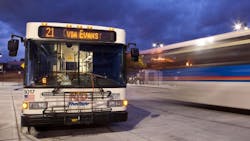Riding transit during COVID-19 is safer than most think when everyone follows basic safety guidelines
The Denver Regional Transportation District (RTD) cites that public health officials are becoming more optimistic that passengers can return to public transit without risking exposure to COVID-19, as the agency reinstates front-door boarding and fare collection throughout the system.
International studies on COVID-19 transmission pathways have not pinpointed clusters of cases related to public transit use, according to national publications like The Atlantic and Bloomberg City Lab. Locally, the agency says there have not been clusters of cases in riders or Denver RTD operators that should concern potential riders, public health officials said, as long as passengers and employees consistently follow guidelines.
“I think mass transit is a perfectly safe alternative if we as individuals and as a community do the basics,” said Dr. Bill Burman, director of Denver Public Health.
Those “basics,” according to Denver and state health officials, include:
- Wearing face coverings at all times, among both passengers and operators. Denver RTD is requiring the use of face coverings by both groups.
- Distancing at least six feet from other passengers, which Denver RTD is facilitating by adding vehicles on busy routes to maintain space between passengers.
- Using hand sanitizer or wipes after riding.
- Staying quiet, as conversation – and, especially, yelling or singing – amplify spread of the virus, officials have said. A quiet car is a safer car.
“The basics work,” Burman said. By abiding by the guidance on this list, he added, “it’s quite reasonable for people to use mass transit.”
Burman and other metro Denver leaders have reviewed both local evidence and the experience of major transit systems around the world and found that transit is not a dangerous vector as once feared, says Denver RTD.
An article in The Atlantic noted a “lack of evidence that public-transit systems have played a role in COVID-19 transmission – and a growing body of research pointing in the other direction.” Further, according to the magazine, “A recent study in Paris found that none of 150 identified coronavirus infection clusters from early May to early June originated on the city’s transit systems. A similar study in Austria found that not one of 355 case clusters in April and May was traceable to riding transit.”
The clusters studied in Paris largely came from other frequently cited risky spaces, including healthcare facilities, workplaces and homeless shelters – “all sites where people mix in enclosed spaces for long periods of time and, in the case of hospitals, where people who are already infected are likely to congregate.”
Bloomberg City Lab noted that in a study of almost a month of French cases, “not a single COVID-19 cluster had emerged on France’s six metro systems, 26 tram and light-rail networks or numerous urban bus routes.” A study of Japanese virus clusters also found none emanating from Tokyo’s “famously packed” commuter trains.
Denver RTD’s system may have an even bigger advantage in that it does not operate underground, tightly enclosed subways, Burman said. Subways remain a higher concern because of lack of air circulation on platforms or in trains, while Denver RTD’s buses and rail cars operate above ground and allow for windows and doors to be opened, for air circulation.
“The information emerging from around the world is encouraging, and RTD is aware of it as we work closely with peer transit agencies to share the lessons we’re learning and our best practices,” said Mike Meader, RTD’s chief safety and security officer and assistant general manager of safety, security and asset management. “To ensure an appropriate response to the coronavirus, we continue to follow the guidance of the World Health Organization, Centers for Disease Control and Prevention, the Colorado Department of Public Health and Environment and the Denver Office of Emergency Management.”
As Denver RTD prepares to get the region moving again, the agency says it is taking additional steps to make travel as safe as possible. Buses are currently being retrofitted with shields between operators and passengers boarding from the front, a process that will be completed in the coming months. In addition, Denver RTD continues to broaden its supplies of personal protective equipment, from face coverings provided to drivers to sanitizing and cleaning supplies.

